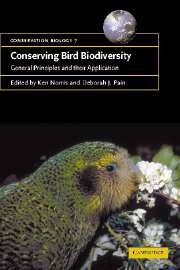Book contents
- Frontmatter
- Contents
- List of contributors
- Preface
- 1 Biodiversity – evolution, species, genes
- 2 Why conserve bird diversity?
- 3 Mapping and monitoring bird populations: their conservation uses
- 4 Priority-setting in species conservation
- 5 Selecting sites for conservation
- 6 Critically endangered bird populations and their management
- 7 Diagnosing causes of population declines and selecting remedial actions
- 8 Outside the reserve: pandemic threats to bird biodiversity
- 9 Predicting the impact of environmental change
- 10 Fragmentation, habitat loss and landscape management
- 11 The interface between research, education and training
- 12 Conservation policies and programmes affecting birds
- References
- Index
6 - Critically endangered bird populations and their management
Published online by Cambridge University Press: 10 December 2009
- Frontmatter
- Contents
- List of contributors
- Preface
- 1 Biodiversity – evolution, species, genes
- 2 Why conserve bird diversity?
- 3 Mapping and monitoring bird populations: their conservation uses
- 4 Priority-setting in species conservation
- 5 Selecting sites for conservation
- 6 Critically endangered bird populations and their management
- 7 Diagnosing causes of population declines and selecting remedial actions
- 8 Outside the reserve: pandemic threats to bird biodiversity
- 9 Predicting the impact of environmental change
- 10 Fragmentation, habitat loss and landscape management
- 11 The interface between research, education and training
- 12 Conservation policies and programmes affecting birds
- References
- Index
Summary
INTRODUCTION
Some bird populations have declined in abundance to critically low levels or have become highly localised. For example, during the period 1979–81 the Chatham Island black robin was reduced to only one effective breeding pair, while by the early 1970s the Mauritius kestrel (Falco punctatus) had declined to four known individuals. Despite such extreme endangerment, both species were saved from the brink of extinction and restored to viability in the wild by conservation management (Jones 1998; Merton 1990). In this chapter, we review the variety and characteristics of critically endangered species, and outline the threats they face and how they are managed. Endangered bird conservation successes and failures are examined, as well as ongoing programmes where the fate of taxa on the brink of extinction remains in balance. To provide reference material for practitioners, lecturers and students, we examine key management techniques before presenting individual case studies covering a diverse range of species and situations. While we focus on birds, the management techniques that we review apply (to a greater or lesser extent) to other taxa.
WHICH ARE THE WORLD'S CRITICALLY ENDANGERED BIRDS?
Within the last 500 years, 128 bird species are known to have become extinct, 103 of these since 1800 (BirdLife International 2000). Currently 1,186 bird species (12% of all birds) are considered threatened with extinction within the next 100 years. Of these, 182 are Critical (15%), 321 Endangered (27%) and 680 Vulnerable (57%); a further three are Extinct in the Wild (BirdLife International 2000).
- Type
- Chapter
- Information
- Conserving Bird BiodiversityGeneral Principles and their Application, pp. 105 - 138Publisher: Cambridge University PressPrint publication year: 2002
- 18
- Cited by

